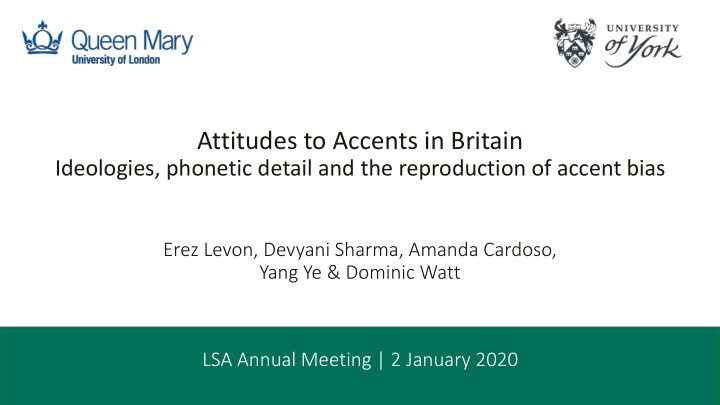



Attitudes to Accents in Britain Ideologies, phonetic detail and the reproduction of accent bias Erez Levon, Devyani Sharma, Amanda Cardoso, Yang Ye & Dominic Watt LSA Annual Meeting | 2 January 2020
“The moment an Englishman opens his mouth, another Englishman despises him.” (George Bernard Shaw, Pygmalion, 1916) ◦ Long-standing patterns of inequality in professional hiring in the UK (Ashley et al. 2015) ◦ Accent is a key signal of social background and can impede access to elite professions (Giles et al. 1975; Kalin et al. 1980; Giles et al. 1981; Alemoru 2015; Roberts et al. 1992) ◦ Specific role of accent in perpetuating unequal outcomes in contemporary Britain under-explored ◦ No large-scale surveys to date of accent attitudes in the UK using audio stimuli (cf. Giles 1970; Hiraga 2005)
https://accentbiasbritain.org @accentbias Erez Levon Devyani Sharma Dominic Watt Grant ref: ES/P007767/1 Amanda Cardoso Yang Ye Christina Perry
Phases of Project Surveys of attitudes to accent concepts and audio stimuli among general UK public and legal professionals Testing influence of “ accentedness ” ratings and dialect density Examining perceptual evaluations in real-time Designing and testing different anti-bias interventions
Phases of Project Surveys of attitudes to accent concepts and audio stimuli among general UK public and legal professionals Testing influence of “ accentedness ” ratings and dialect density Examining perceptual evaluations in real-time Designing and testing different anti-bias interventions
Attitudes to Accent Concepts ◦ Replicated Bishop et al.’s (2005) study of attitudes to accent labels (cf. Giles 1970) ◦ Nationally representative sample of UK public (N=827) ◦ Respondents rated 38 accent labels for prestige and pleasantness
Attitudes to Accent Concepts ◦ Replicated Bishop et al.’s (2005) study of attitudes to accent labels (cf. Giles 1970) ◦ Nationally representative sample of UK public (N=827) ◦ Respondents rated 38 accent labels for prestige and pleasantness Cockney Essex
Attitudes to Accent Concepts ◦ Replicated Bishop et al.’s (2005) study of attitudes to accent labels (cf. Giles 1970) ◦ Nationally representative sample of UK public (N=827) ◦ Respondents rated 38 accent labels for prestige and pleasantness ◦ Enduring hierarchy of prestige ratings across accents National and Inner Circle varieties top-ranked Industrial and ethnic varieties bottom-ranked ◦ Significant differences in ratings by respondent age Younger respondents (< 45) rate non-standard accents higher than older respondents Top-ranked accents rated similarly across all ages Relative rankings are stable , but objective ratings change
Conceptual accent evaluation arguably taps into deeply conservative ideologies of language, obscuring socio-psychological shifts over time and contextual effects. (Bishop et al. 2005) Are such accent preferences evident with audio stimuli? in relation to an actual person ? in a situated context?
Attitudes to Voices ◦ Verbal guise study with representative sample of population in England (N=848) ◦ Listeners evaluated interview performance of “candidates” for trainee solicitor position at a corporate law firm ◦ Candidates were young men, native speakers of 5 English accents (2 speakers/accent) : ◦ Received Pronunciation (RP) ◦ Estuary English (EE) ◦ Multicultural London English (MLE) ◦ General Northern English (GNE) ◦ Urban West Yorkshire English (UWYE) ◦ Stimuli were audio responses to interview questions, some requiring legal expertise and others focussing on more general professional skills (developed with lawyer consultants) RP EE MLE GNE UWYE
Attitudes to Voices ◦ Listeners rated all 10 speakers (each responding to a different interview question): How would you rate the overall quality of the candidate's answer? Does the candidate's answer show expert knowledge? α = 0.96 In your opinion, how likely is it that the candidate will succeed as a lawyer? Is the candidate somebody that you personally would like to work with? How would you rate the candidate overall?
Attitudes to Voices ◦ Listeners rated all 10 speakers (each responding to a different interview question) ◦ After rating listeners provided information about their social and linguistic backgrounds, including: region, gender, age, class beliefs about social motivation to control and networks mobility in the UK prejudiced reactions (e.g., McConahay 1986) (e.g., Dunton & Fazio 1997)
Attitudes to Voices ns
Attitudes to Voices ns ***
Attitudes to Voices
Linguistic Detail ◦ Developed exhaustive lists of variants in each accent that are distinctive from RP FACE GOOSE TH GOAT THOUGHT DH PRICE NURSE glottals MOUTH STRUT/FOOT l-colouring BATH/TRAP r-sandhi happY ◦ Calculated unweighted and weighted counts of features for each response in each accent ◦ Examined correlations between distinctive feature counts and evaluations
Linguistic Detail
Linguistic Detail What is the difference between contract and tort? 19 Δ = 29 Δ = 28 14 42 48
Linguistic Detail What is the difference between contract and tort? *** ns
Summary ◦ Enduring hierarchy of accent prestige in the UK ◦ Pattern most pronounced for accent concepts and mitigated for audio stimuli in mock interview contexts ◦ Accent evaluations are moderated by respondent age (and by region and Motivation to Control Prejudiced Response) : appears more indicative of age-grading than attitudinal change ◦ “Accent” not always object of evaluation: importance of accent strength , with some features (accents) penalized more than others (cf. current work on Dialect Density and subjective “ accentedness ” ratings)
Thank You! https://accentbiasbritain.org @accentbias accentbiasbritain@qmul.ac.uk
Results *** ***
Results *** ***
Recommend
More recommend